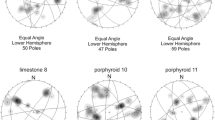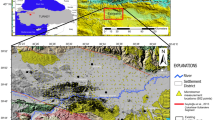Abstract
To dimension a geothermal array, it is necessary to explore the geophysical and geologic qualities of the subsoil. At the following example the project engineering of a prospective geothermal array is shown from the investigation up to the execution planning. For the geothermic investigation a 400 m (1312 ft.) deep drilling was established and equipped with 50 mm (1.97 in.) duplex BHE. With the mounting of the BHE a fiberglass hybrid cable was inserted as a loop parallel to the shanks of the BHE. By means of optical frequency domain reflectometry (OFDR) an enhanced geothermal response test has been executed. Due the high local resolution of the resulting profile of conductivities the geological profile can be differentiated in areas with mainly conductive and areas of convective influenced heat transfer. By knowledge of these both parts and its parameters the incident of groundwater flow on the BHE can be calculated (Peclet number analysis/ Darcy velocity). With the help of the ascertained geophysical and hydraulic rock parameters solid rock, cleavages and karst cavity could be identified. Also the undisturbed ground temperature, the effective thermal conductivity and areas with different geothermal gradients and the groundwater velocity in cleaved and caveated rocks could be determined.


















Similar content being viewed by others
Abbreviations
- a:
-
Thermal diffusivity (m2/s)
- \(\rho\) c p :
-
Volumetric heat capacity [MJ/(m3 K)]
- erf(x):
-
Gaussian error function
- H :
-
Length of BHE (m)
- Ei(x):
-
Exponential integral
- I 0(x):
-
Cylinder function after Bessel
- l :
-
Length of pipe (m)
- \({\dot{Q}}_{H}\) :
-
Specific heat input (W/m)
- r :
-
Effective radius of the heat source (m)
- r 1 :
-
Inner radius of pipe (m)
- r 2 :
-
Outer radius of pipe (m)
- R :
-
Radius of cylinder source (m)
- R B :
-
Thermal resistivity (K m/W)
- R Beff :
-
Effective thermal resistivity (K m/W)
- T f :
-
Mean temperature of the heat exchanger fluid (°C)
- T 0 :
-
Average undisturbed temperature of ground (°C)
- t :
-
Time (s)
- x, y, z :
-
Cartesian coordinates
- \(\tau\) :
-
Function of time
- \({\vartheta}_{in}\) :
-
Input temperature of heat exchanger fluid (°C)
- \({\vartheta}_{out}\) :
-
Output temperature of heat exchanger fluid (°C)
- \({\vartheta}_{0}\) :
-
Average undisturbed temperature of ground (°C)
- \(\Delta\vartheta\) :
-
Difference of temperature [K]
- \({\vartheta}_{1}\) :
-
Inner temperature of pipe on r 1 (°C)
- \({\vartheta}_{2}\) :
-
Outer temperature of pipe on r 2 (°C)
- \(\pi\) :
-
Pi 3.141…
- \(\vartheta\) :
-
Temperature (°C)
- \(\varphi\) :
-
Time-dependent function over radius
- \({\zeta},{\psi},{\xi}\) :
-
Time-dependent functions over x, y, z direction
- \(\gamma\) :
-
Euler constant 0.5772…
- \(\lambda\) :
-
Thermal Conductivity [W/(mK)]
- \({\lambda}_{Eff}\) :
-
Effective thermal conductivity [W/(mK)]
- \({\lambda}_{Mat}\) :
-
Thermal conductivity of a material (i.e., grout, polyethylene) [W/(mK)]
- ϕ:
-
Inclination of temperature curve over logarithmical time scale
- \(q_{a }\) :
-
Convective thermal flow (W/m2)
- \(q_{c}\) :
-
Conductive thermal flow (W/m2)
- \(\rho\) :
-
Density of fluid (kg/m3)
- \(c_{p}\) :
-
Specific heat capacity of fluid at constant pressure [J/(kg/K)]
- \(v_{f}\) :
-
Darcy velocity of fluid (m/s)
- \(\Delta T\) :
-
Thermal spread (K)
- \(\lambda ,\lambda_{\text{cond}}\) :
-
Thermal conductivity of solid [W/(mK)]
- \(\lambda_{\text{conv}}\) :
-
Thermal conductivity of fluid [W/(mK)]
- \(l_c\) :
-
Characteristic length (m)
References
Carslaw HS, Jaeger JC (1959) Conduction of heat in solids, 2nd edn. Oxford University Press, Great Britain
Di Sipio E, Galgaro A, Destro E, Teza G, Chies S, Giaretta A, Manzalla A (2014) Subsurface thermal conductivity properties at a regional scale: the Calabria Region case study (southern Italy). Environ Earth Sci (this issue)
Eskilson P (1987) Thermal analysis of heat extraction boreholes. Lund-MPh-87/13. Department of Mathematical Physics, Lund Institute of Technology, Sweden
Feldbusch E, Regenspurg S, Banks J, Milsch H, Saadat A (2013) Alteration of fluid properties during the initial operation of a geothermal plant: results from in situ measurements in Gro Schonebeck. Environ Earth Sci 70:3447–3458
Francke H, Kraume M, Saadat A (2013) Thermal-hydraulic measurements and modelling of the brine circuit in a geothermal well. Environ Earth Sci 70:3481–3495
Gehlin S (2002) Thermal response test—method development and evaluation. Doctoral Thesis:39. Lund Institute of Technology, Sweden
Heidinger G, Dornstädter J, Fabritius A,Welter M, Wahl G, Zurek (2004) EGRT—Enhanced Geothermal Response Test. In: Proceedings 8. Geothermische Fachtagung, 316–323
Hellström G (1991) Ground Heat Storage, Thermal Analysis of Duct Storage Systems, I. Theory. 282 S, Department Mathematical Physics, University of Lund, Sweden
Ingersoll LR, Plass HJ (1948) Theory of ground pipe heat source for the heat pump. ASHVE Trans 47:339–348 Chicago
Lord Kelvin (1856) Compendium of the Fourier Mathematics for the conduction of heat in solids, and the mathematically allied physical subjects of diffusion of fluids and transmission of electrical signals through submarine cabels. Q J Math 1
Mogensen P (1983) Fluid to duct wall heat transfer in duct system heat storages. In: Proceedings of the International Conference on Subsurface Heat Storage in Theory and Practice. Swedish Council for Building Research. Stockholm, Sweden, pp 652–657
Nelder JA, Mead R (1965) A simplex method for function minimization. Comput J 7(1):308–313
Rogers G, Mayhew Y (1967) Engineering thermodynamics work and heat transfer, 4th edn. Pearson Education Limited, Great Britain
Schwartz A, Großwig S, Pfeiffer T (2014) New technologies in hydraulic engineering—the usage of fiber optics. Environ Earth Sci (this issue)
Sanner B et al (2007) Technology, development status, and routine application of Thermal Response Test. In: Proceedings European Geothermal Congress. Unterhaching, Germany
Sass I, Lehr C (2011) Improvements on the Thermal Response Test evaluation applying the cylinder source theory. In: Proceedings Thirty Sixth Workshop on Geothermal Reservoir Engineering Stanford University, Stanford, California
Signorelli S (2004) Geoscientific Investigations for the use of Shallow Low-Enthalpy Systems. Doctoral Thesis 2004. Swiss Federal Institute of Technology Zurich, Switzerland
VDI (2001) VDI-Guideline 4640: Thermal use of the underground—ground source heat pump systems. Beuth, Berlin
Zschocke A (2005) Correction of non-equilibrated temperature logs and implications for geothermal investigations. J Geophys Eng 2:364–371
Author information
Authors and Affiliations
Corresponding author
Additional information
Conference Topics: Thermal use of the shallow subsurface.
Rights and permissions
About this article
Cite this article
Lehr, C., Sass, I. Thermo-optical parameter acquisition and characterization of geologic properties: a 400-m deep BHE in a karstic alpine marble aquifer. Environ Earth Sci 72, 1403–1419 (2014). https://doi.org/10.1007/s12665-014-3310-x
Received:
Accepted:
Published:
Issue Date:
DOI: https://doi.org/10.1007/s12665-014-3310-x




